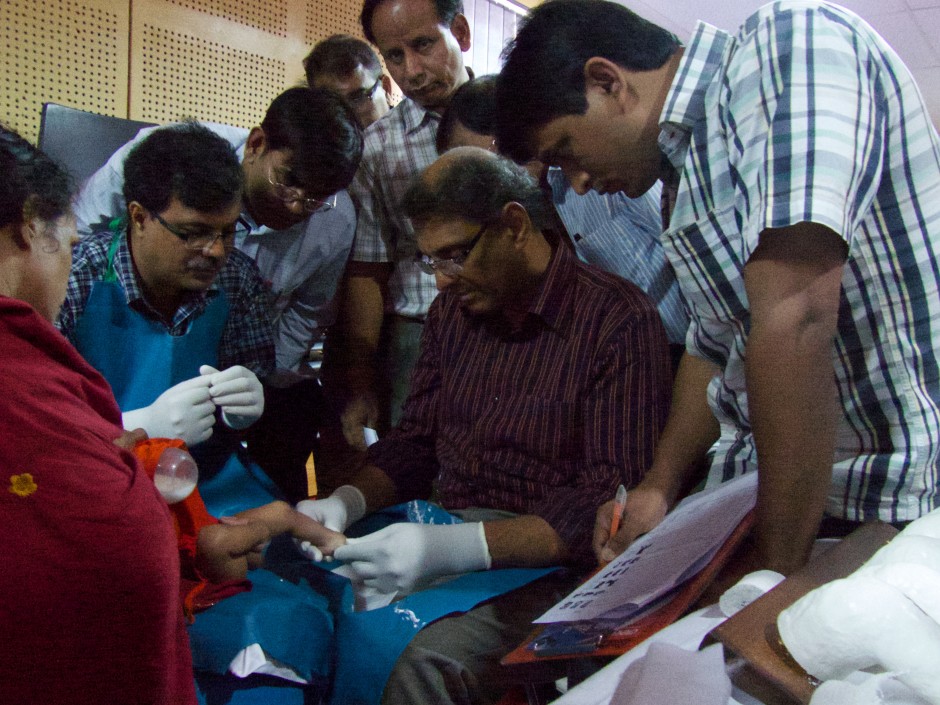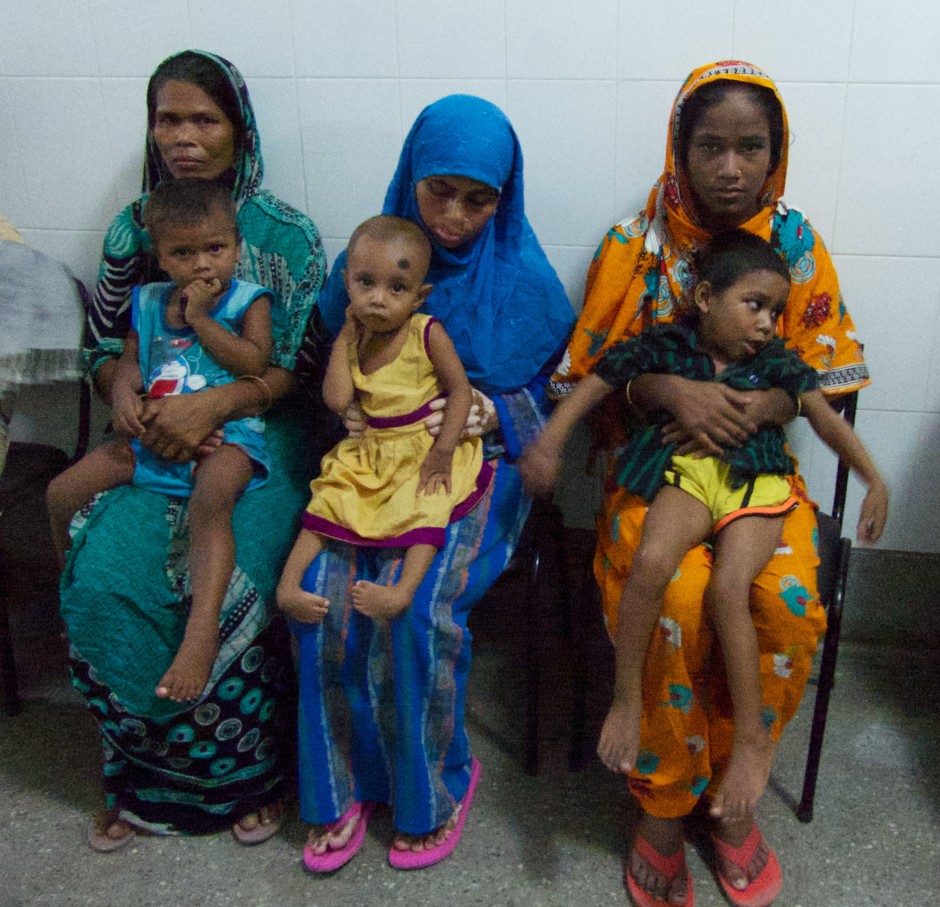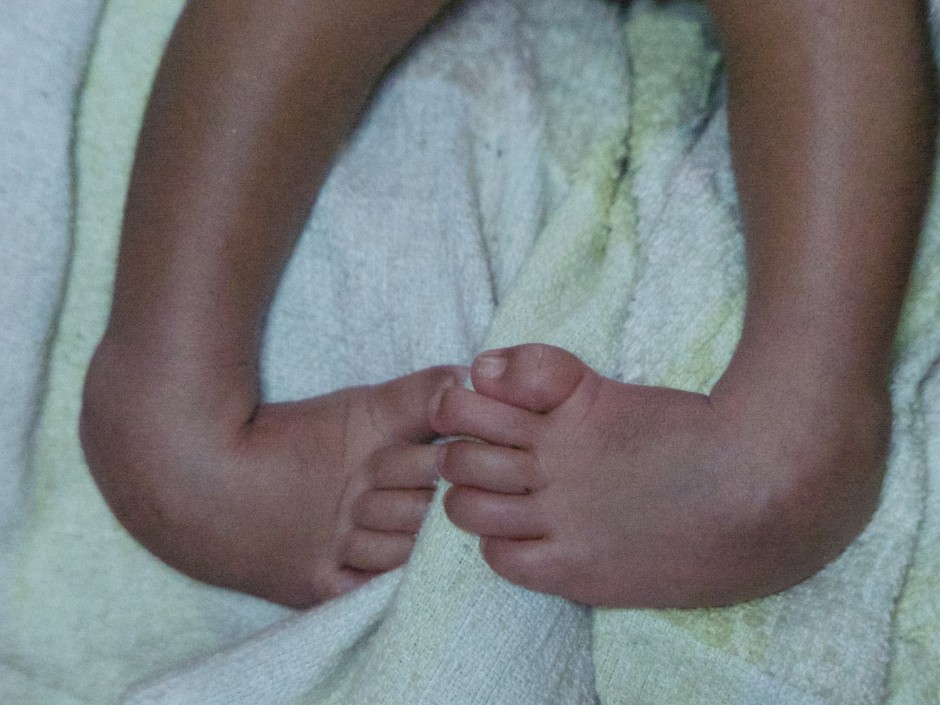
Shafique Pirani, centre, demonstrates the Ponseti technique to Bangladeshi orthopaedic physicians. Photo: Lynn Staheli
Upon hearing how Shafique Pirani aims to eradicate clubfoot in Bangladesh, it’s tempting to assume he is a bit deluded by the myth of the all-powerful doctor.
And then you listen to him – speaking softly and melodically, in gentle cadences punctuated by a nurturing, warm smile – and skepticism quickly morphs into hope.
And then you look at what he has already done, and hope becomes belief.
A Clinical Professor in the Department of Orthopaedics who practices at Royal Columbian Hospital in New Westminster, Dr. Pirani has spent the past decade spreading the word about a non-surgical method of curing clubfoot, a condition in which a child is born with one or both feet turned inward and downward. Left untreated, clubfoot is a lifelong disability.
The method, invented by the late Ignacio Ponseti of the University of Iowa, involves gently manipulating a baby’s foot, placing a cast on it, and then repeating the process over several weeks, so that the mainly cartilaginous bones are molded into the correct position. Night braces help maintain that position until the bones harden into place.
With funding from the Canadian International Development Agency (CIDA), he and Richard Mathias, a Professor in the School of Population and Public Health, worked with Uganda’s Makerere University and Ministry of Health to create a network of 40 clinics throughout the country, staffed by “orthopaedic officers” who can provide the Ponseti treatment. Over the course of the grant, 3,227 children were treated, and the clinics remain open to treat thousands more in the years to come.
Buy-in from Bangladesh
As is the case in Uganda and other developing countries, clubfoot in Bangladesh is far more of a burden – for the individual, family members and society – than it is in a country like Canada, because the main mode of transportation is walking, and farming and manual labour are the main occupations.
“The link between clubfoot and poverty is unmistakable, made visible by the fact that many of the beggars in Bangladesh have the condition,” Dr. Pirani says.
So Canada’s Department of Foreign Affairs, Trade and Development (the successor to CIDA), doubled down on Dr. Pirani, awarding him $4.3 million to establish Sustainable Clubfoot Care in Bangladesh (SCCB).
The Bangladesh project is markedly different from the one in Uganda, where specially-trained paramedical workers were trained to perform most parts of the Ponseti procedure. In Bangladesh, only orthopaedic physicians are allowed to do it.
But the country’s Ministry of Health is also committed to training thousands of health care workers – other physicians, nurses, and village- or neighborhood-based health outreach workers – to recognize the condition, explain to parents how it can be treated, refer them to the appropriate clinic, and then follow up to make sure that the child wears a nighttime brace for four years after the casting to prevent relapse.
A cascade of training
Dr. Pirani and his team are using a train-the-trainer model, starting with the instruction of 50 orthopaedic “master trainers,” who will share their new knowledge and skills with fellow orthopaedic surgeons, orthopaedic residents, paramedical institute instructors and nursing school instructors. While the orthopedic physicians will provide treatment, the instructors will orientate paramedical students and nursing students to the treatment so they can identify and refer patients.
The same orientation will also take place with medical students, and for non-orthopaedic physicians through professional societies.
The master trainers also will work with BRAC, a humanitarian organization based in Bangladesh (and the largest nongovernmental organization in the world), to orientate 50,000 outreach workers – known as “Shasthya Shebikas” and “Shasthya Kormis” – to identify children with clubfoot, refer them for treatment and follow up.

Children with foot deformities wait with with their mothers to be assessed at one of Dr. Pirani’s training session in Dhaka. Photo: Lynn Staheli
“Our main point of contact in BRAC made a call, and from there it went down the pyramid,” Dr. Pirani recalls. “Forty-eight hours later, we had 100 children come to the clinic, and 29 of them had clubfoot. They knew who in a slum of 1.3 million people had a foot problem, and got them on a bus.”
Sharing lessons, answering questions
At the training session, Dr. Pirani shared some of his own hard-won insights into the Ponseti treatment, including the effectiveness of keeping the child on the mother’s lap – and even letting the child breastfeed – during the manipulation and casting.
“This is an alien concept to orthopaedics, where the vast majority of procedures are done in the operating room,” Dr. Pirani says. “And it’s even more so in a Muslim society, where public breastfeeding is not as common. But you have to make sure the child is relaxed.”
More lessons are bound to follow – Dr. Pirani and Dr. Mathias are not only looking to effect change, but to conduct research that can be applied elsewhere. Some of the questions he wants to answer:
-
What are the risk factors for not continuing the bracing?
-
How can diagnosis and referral be better integrated into primary care?
-
What is the minimum duration of treatment for a successful outcome?
- How can outcomes be better quantified?
“Once we show how feasible this approach is, and how much of an impact such a coordinated response can have, I expect more countries will want to adopt it as well,” Dr. Pirani says. “And then, we will be well on our way to hastening the demise of clubfoot, and the poverty and social isolation that comes with it.”
